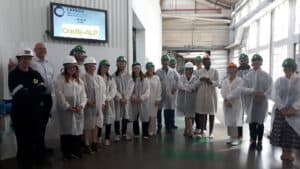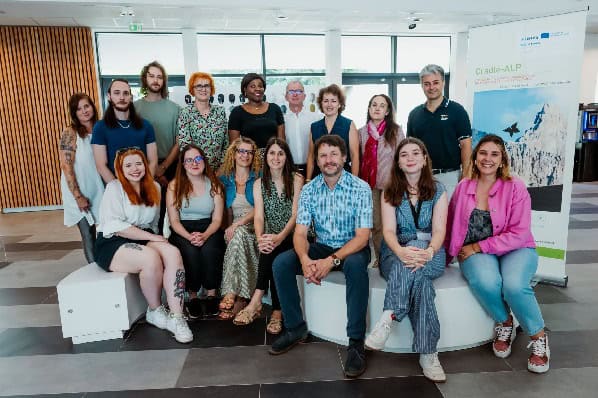CRADLE-ALP 2024
The Cradle-ALP project team made significant progress in 2024. By conducting interviews with industry leaders, creating five transformation roadmaps, and organizing hands-on activities like study visits, the project built a strong foundation for a circular economy and showcased the real benefits of using cradle-to-cradle (C2C) principles. As 2025 begins, the Cradle-ALP team is excited to move forward with pilot actions. But first, let’s reflect on the past year!
INSIGHTS FROM INDUSTRY LEADERS
We started the year with a series of interviews conducted with industry leaders and practitioners, which provided valuable insights into the practical challenges and benefits of implementing C2C principles. Leaders from sectors such as textiles and packaging highlighted the importance of material innovation, consumer awareness, and regulatory support in driving the transition.
While challenges such as supply chain limitations and inconsistent consumer demand were acknowledged, many companies reported significant successes. A packaging firm shared how mono-material solutions simplified recycling processes, while a furniture manufacturer highlighted a 20% cost reduction achieved through modular designs. These success stories underscore the economic and environmental value of circular practices.
The interviews also emphasized the importance of collaboration. With this in mind, we organized workshops with different stakeholders, where we identified and categorized the most important short-term, mid-term, and long-term activities to integrate C2C principles into different industrial sectors.
INDUSTRIAL TRANSFORMATION ROADMAPS: A BLUEPRINT FOR THE FUTURE
One of the most notable achievements of 2024 was the introduction of comprehensive transformation roadmaps for five key sectors: wood and furniture, textiles, polymer-based composites, chemistry and materials, and packaging. These roadmaps provide clear, actionable steps for small and medium-sized enterprises (SMEs) to transition toward sustainable and circular practices by 2035.
Wood and Furniture Roadmap
The roadmap for the wood and furniture sector emphasizes certified sustainable sourcing, integrating AI and IoT for resource and waste management, and fostering innovation through cross-sector collaborations. The first steps aim to validate sustainable materials and assess their impact on biodiversity. Future steps include scaling advanced technologies for lifecycle management and promoting closed-loop supply chains. You can find the wood and furniture roadmap here.
Textiles Roadmap
The textiles roadmap focuses on addressing challenges in recycling, material traceability, and transparency through innovative practices like product passports and mono-material designs. Short-term activities include public databases for recycling technologies and pilot projects for recycling and reuse. Long-term goals involve harmonized EU regulations and establishing dedicated textile waste industries. You can find the textiles roadmap here.
Polymer-Based Composites Roadmap
The roadmap for the polymer-based composites sector tackles the recycling challenges of fiber-reinforced plastics by promoting bio-sourced materials and developing public resources for second-life solutions. Immediate actions include creating databases of recycling technologies and establishing Extended Producer Responsibility (EPR) schemes. By 2035, the industry aims to reduce landfill disposal of composite waste to 10%. You can find the composites roadmap here.
Chemistry and Materials Roadmap
In the chemistry and materials sector, the roadmap emphasizes the development of standards for recyclate qualities, prioritization of sustainable chemicals, and digitization through tools like digital material IDs. Mid-term efforts focus on aligning regulations across Europe and incentivizing the use of bio-based resources. Long-term structural changes include harmonizing EU tax laws and sustainability claims to prevent greenwashing. You can find the chemistry and materials roadmap here.
Packaging Roadmap
The packaging roadmap addresses material optimization and circular design integration for plastics and paper. Short-term activities involve developing recycling technologies and EPR schemes, while mid-term initiatives include implementing ISO standards and closed-loop systems. By 2033, the roadmap envisions widespread adoption of biodegradable materials and harmonized EU sustainability regulations. You can find the packaging roadmap here.
These roadmaps present an overview of possible steps toward a greener future. These roadmaps outline possible steps toward a greener future. To learn more about our approach, watch this video.
A HANDS-ON APPROACH: STUDY VISIT TO CLERMONT-FERRAND
We believe that the best way to inspire is by example. That is why we also took a practical approach to knowledge-sharing through a study visit to Clermont-Ferrand, France. We visited two amazing companies. The first was CARBIOS, a pioneering company in the field of enzymatic recycling of plastics. We were impressed by their technological advancements and their commitment to a more sustainable future. We had the privilege of visiting their industrial demonstrator dedicated to plastics and textiles.
After that, we explored the work of CMD (Center for Sustainable Materials) and Michelin on advanced materials and their contributions to industrial sustainability. This includes the renovation of industrial buildings that will soon host innovative companies like CARBIOS, aiming to scale up their innovations.
The study visit provided an invaluable platform for learning, networking, and fostering partnerships. We left inspired by the tangible examples of circular innovations and equipped with actionable insights to share with our networks and businesses.

LOOKING AHEAD: PILOT ACTIONS IN 2025
As the Cradle-ALP project concludes a transformative year, the focus now shifts to 2025, where the next phase is focused on implementing pilot actions across the Alpine region. These pilot programs are building on the lessons learned from 2024, testing the feasibility of C2C practices in real-world settings and scaling successful models.
The pilot actions will involve close collaboration with SMEs, policymakers, and researchers, ensuring a holistic approach to sustainable transformation. Participants will have the opportunity to explore innovative solutions, refine their strategies, and contribute to a growing body of knowledge on circular economy practices.
Urška Spitzer, CCIS



